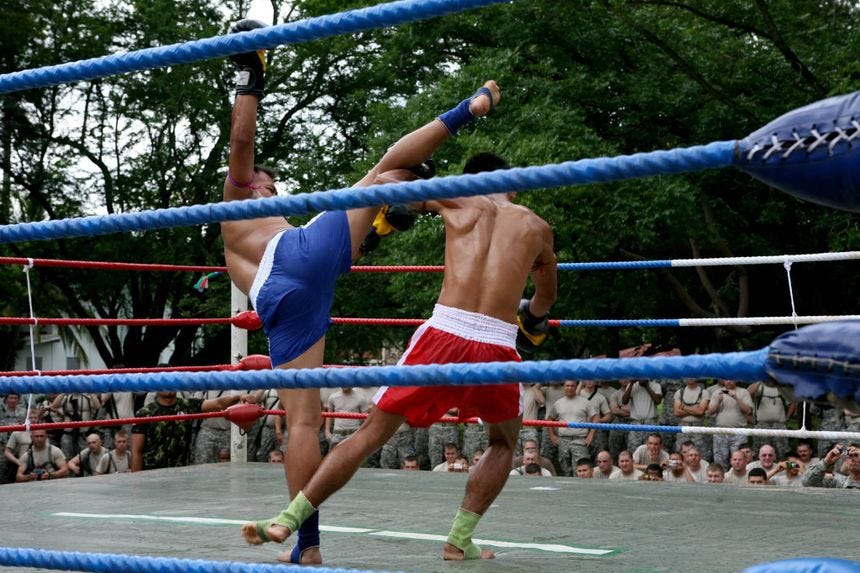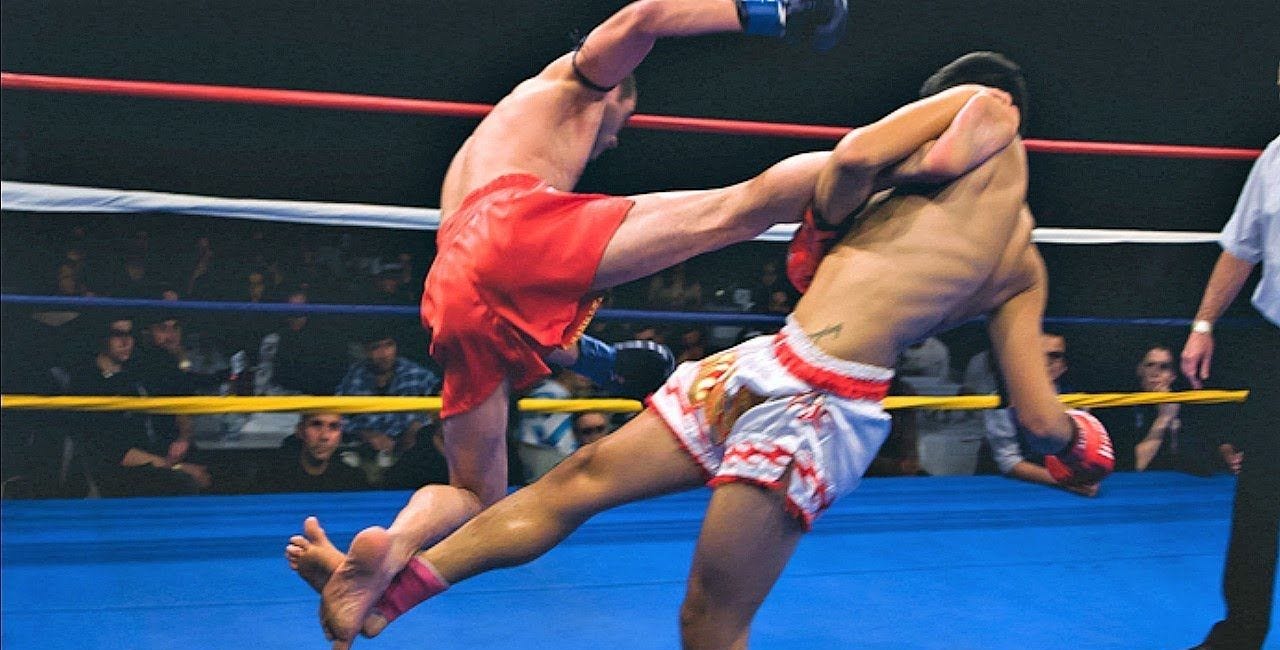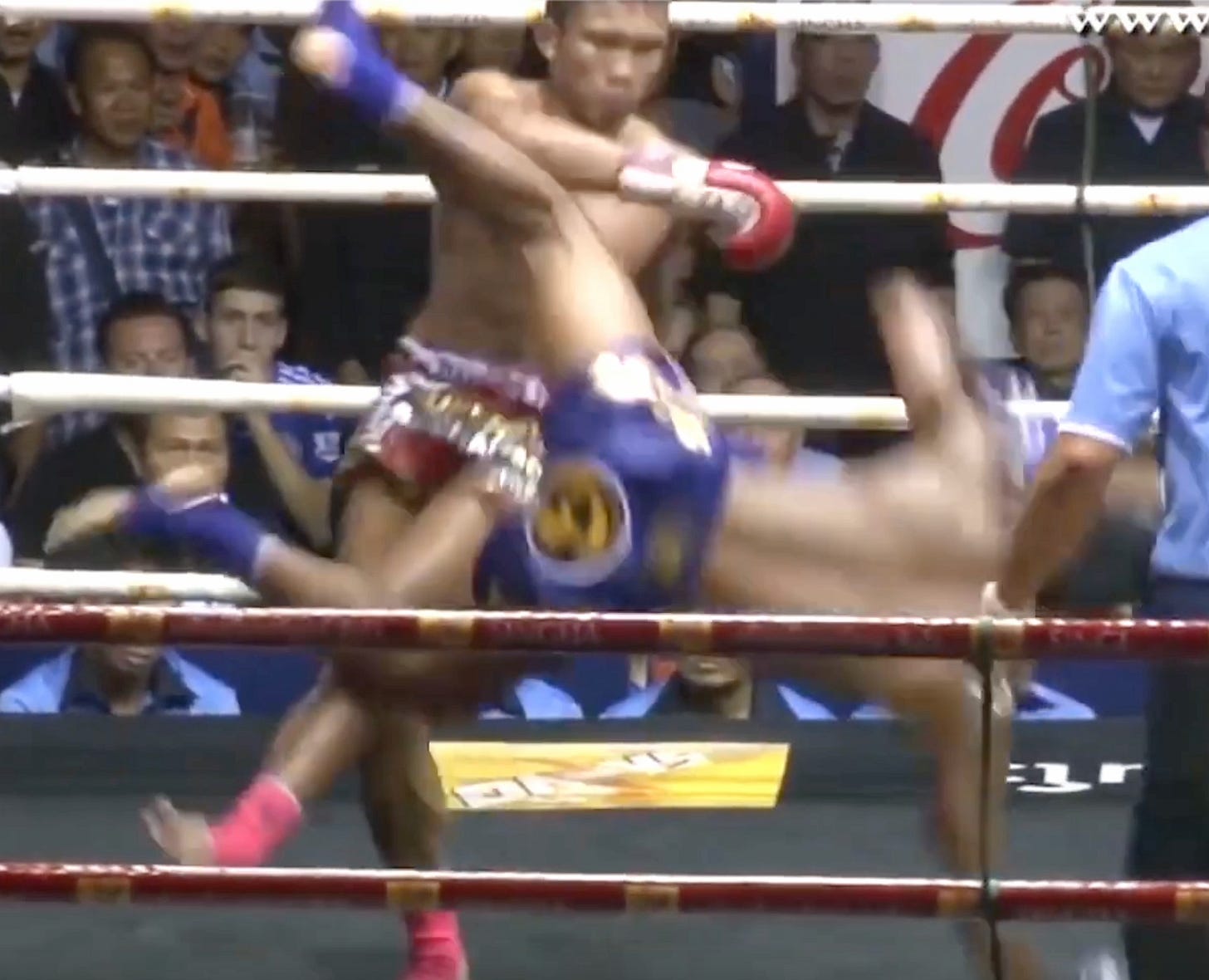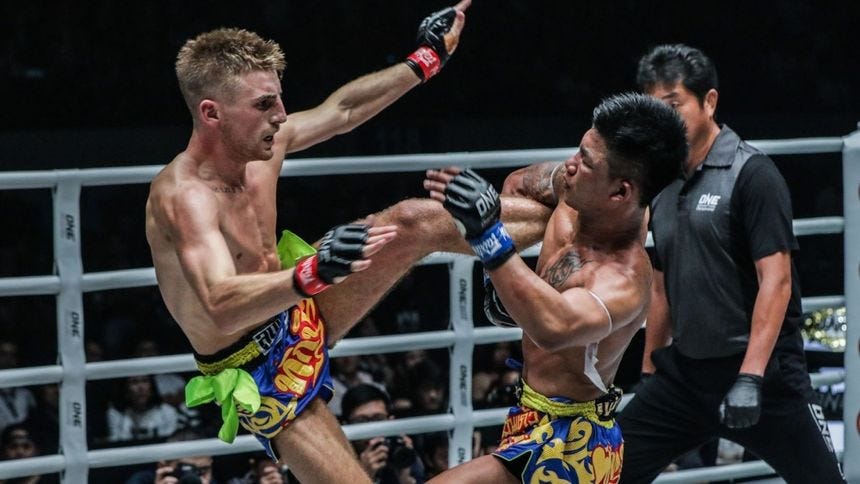Sweeping Out the Competition: Muay Thai
Nerding Out over Beautiful Techniques
*I’d like to thank the YouTube channel Muay Thai Scholar for having compilations of many of the fighters I studied for this article. He hasn’t posted in five months, but I hope he is doing well, and you should check out his channel*
Get the opponent on their back, and make it looks easy. This is the goal in any combat sports. Take them down in wrestling, knock them down in boxing, and you’ll be winning on top in MMA. Nothing says “I’m better than you” than getting someone on their back in Muay Thai.
Unlike in modern boxing, kickboxing, or even 4 oz Muay Thai today, the clinch is an integral part of one’s offensive capabilities in stadium Muay Thai. Fighters are not separated from a clinch unless there is a protracted lull in the action. Fighters instead opt to throw knees from in close, elbows, or get their opponent to the ground. Also, Thai fighters can catch kicks and execute offense, run them through to the ground, or sweep, which is not the case in kickboxing.
Thank God for that.
Sweeps and trips are just about the craftiest things you can see in a Muay Thai fight. Muay Thai has this reputation for savagery and brutality, and rightly so (especially in the 4 oz gloves). However, this all changes when you see an elite operator bring his opponent to the ground with minimal effort. It’s BEAUTIFUL. Sweeps and trips broaden your perspective as to what fighting can be. Combat sports are hurt sports, but they’re not JUST hurt sports. Style and craft can be just as pertinent. A great knockout stuns a crowd but listen to a crowd when Superbank or Saenchai are fighting. When they hit a sweep, the crowd responds with cheeky admiration. The kind of “Ooos” and “aaahs” tinged with laughter. The opponent was made to look silly.
Read this article if you want to see how this series was conceived:
Sweeping Out the Competition: Meta
Thanks for reading Combat Codex! Subscribe for free to receive new posts and support my work. Punches? WACK Ground grappling? WACK Trips, sweeps, and throws? THEY’RE TIGHT AS FUCK Where the How to MMA series focuses on how a fighter utilizes a particular technique, I seek to look more broadly at how a technique is utilized across combat sports.
Its not all about practicality. Embrace Beauty in Violence.
These techniques have a layered practicality to them. Hit head —> hurt or knockout, hit body —> slow down or knockout, hit legs —> slow down to get knockout. It is obvious why you should strike someone. In a striking sport the knockout is king Why bother with sweeps or trips?
Disclaimer: The video clips included in this article are not owned by the author. They are included for educational purposes only to illustrate key moments in the fighter’s career and demonstrate aspects of mixed martial arts techniques and strategies. All rights to the video content belong to their respective owners.
Get ‘em Tired
In the most obvious sense, you can get someone really tired by bringing them to the ground over and over again. Forcing an opponent to stand up over and over again doesn’t do nothing. They have to fight against gravity while you stand and catch your breath. It’s not a knockdown, where they go to battle with nature and their consciousness, but it’s SOMETHING. At the elite levels, these slivers of “something” can turn into everything. Make them that much more tired, and you get that much closer to winning.
If you dump the opponent to the ground hard enough, it can also do some damage and even knock the wind out of them if they fall right.
Just an all-time great TKO by sweep by Saenchai. Legend.
Tiring them out is the primary benefit, but if they land right you can make their fight back to their feet that much more difficult. Consider the prospect of doing damage through these a “bonus” rather than an advantage.
A Stalwart Defense
Though offensive in nature (you are executing a sweep ON your opponent), these techniques are built upon a solid defensive foundation in Muay Thai. Before you sweep, you have to catch an opponent’s kick. Before you trip them, you have to clinch them without getting hit. Defense on its own is never enough. No one wins by not getting beat (cue people telling me about Willie Pep’s mythic round), people win with ACTION. The sweep or trip is the CONSEQUENCE and opponent receives for executing a particular action. You can merely prevent their attack, but it is a much better idea to make them pay for attacking you in the first place.
In the micro sense, this is good, as you have prevented damage and taken the opponent down within an exchange. On the macro scale, its effects are even greater. In the above sequence Saenchai slides back from the head kick matrix style. Though devastating, the main detriment to a head kick is that it leaves you terribly out of stance after throwing it. Saenchai needs only a smidge of effort to catch the opponent as he comes in side-on, tilt his upper body down, and take out the weight-bearing leg. Do that once, and he will probably try and get his offense off again. Now do it again. And again. And now sweep him one more time for having the gall to attempt that technique yet again. How do you think the opponent is going to feel? A weapon that they might have leaned on in previous fights is now rendered useless, because they get sent to the ground every time they attempt it.
Congratulations.
You have just taken away one of your opponent’s weapons, and you are now winning the mental battle of the fight.
So many sweeps can be executed off of caught kicks. You HAVE to know how to catch a kick correctly while mitigating damage if you are to capitalize upon a sweep. You can sweep them off of the body kick every single time, but if you are not preventing the damage of the body kick when catching it, you will certainly wear out faster then your opponent.
This is not to say that your opponent will not have other tricks, or the mental fortitude to be unfazed. You are STILL forcing the opponent to react. YOU are the proactive party in the fight, and they must now react to your sweeps but swapping their weapon, finding a new way to set it up, or looking for a new strategy entirely. In the ring, this can be the deciding factor more than any technique on its own.
“Momentum” is a word thrown around a lot during fights, and it can seem like one that is overused to describe who is “in control” of the action. Though this goes for any defensive technique, sweeping an opponent off a body kick 4 times will almost assuredly put the momentum of the fight in your favor.
Demoralization
It is a tall task to control your opponent in a striking sport. The prospect of receiving damage, counters, and getting knocked out at any point means more variables with dire consequences. Crawford’s domination of Spence is a rare example of this in a striking art, but it is EXTREMELY difficult to do. Even when a fighter is getting bounced around the ring, most maintain the thought “If I can just hit this one shot, everything will change.”
This is cleaner than just about anything, and can only be executed with the right intuition from reps in the gym. They both raise a knee on the same side, and as they lower each, Superbank’s opponent throws the body kick. He is too late though, as Superbank anticipates this and sweeps the standing leg out right at the ankle. Minimal effort, and craft. The ideal sweep that leaves the opponent feeling stupid.
Though you can say the same about a submission, it is much more difficult than finding the timing to throw and *boop* your opponent dead in an instant. There needs to be ~some~ change in control or momentum for a submission to even be attempted. Grappling is built upon the foundation of controlling your opponent and preventing their movement. Though it is not that simple, everyone has heard the story of the big 200+ guy going into a BJJ gym for the first time and getting tooled by the scrawny purple belt. You will constantly get utterly wiped across the floor like a mop in grappling, and you only get good by learning how to prevent it. This process is utterly DEMORALIZING. To feel useless, and like you can’t do a thing to stop another man from grinding your face into a mat. The only thought that comes is usually akin to “What the FUCK dude?”.
This element of grappling in Muay Thai can have the exact same effect. Whether in the clinch or from a caught kick, it is the same. Get in the clinch and try and throw them, throw some elbows, or knees and *boop*, on your back. The more frustrated you get, the more desperate and sloppy your offense becomes, and easier it is to off-balance you. Keep kicking, and kicking, and kicking, and get swept even 60% of the time? That sucks. All of your offense is effectively rendered useless, and you keep being made to look like a fool. The spiritual degradation of this process is nothing to sniff at. Sure, you might not get your opponent out of there immediately, but you are going to make them desperate. With their desperation can come an increased vigor, but also openings. On the spiritual battlefield, trips and sweeps in Muay Thai are ultimate weapons.
Now that we understand the usage of trips and sweeps on the macro sense, let’s take our magnifying glass out, and look at them on the micro.
What Makes a Good Sweep?
Set-Up
In order to sweep someone, you need to get them on one-leg. Two of the most reliable set-up to bring opponent’s onto a leg are to let them think that you are going to kick them, or to bait them into kicking you.
Saenchai is one of the greatest Muay Thai fighters of all time, and an element of that is that he is a master sweeper. This sequence is a classic set up of his.
Sanechai does a stutter step, bringing his back leg forward and his hands down like he is going to kick. This baits the opponent into raising their leg to check the incoming kick. This works best with a dedicated leg and body attack established prior throughout the fight.
Instead of throwing the kick, Saenchai squares his stance kicking through the opponent’s checking leg to their outside knee. His lead hand punches through past their head, and posts on the opposite side.
With his sweeping foot at their far and checking leg, and his hand firmly on the far side of their head, he need only chops their head to the floor and bring their legs up. The opponent is left parallel to the floor in midair, and have only have one way to go.
The beauty of this sweep really is in the set-up. Saenchai convinces the opponent that the kick is coming and forces them to defend. You can’t REALLY sweep an opponent firmly planted on both of their feet without extreme effort. In order to get the full effect of SWEEPING an opponent off of their feet, rather than simply unbalancing them, you need to get them on ONE weight-bearing beam.
This example is similar, but somewhat cleaner in that Saenchai is able to sweep the opponent out from the ankle. It sits him down and he really cannot do anything about it. The same exact set-up is shown here is well. Saenchai brings his back foot forward into a very narrow stance to feint a kick, but he springboards out of this narrow stance to execute the sweep.
This man has just been sonning people with this sweep for YEARS, and it works against everybody BECAUSE he can convince opponent’s that the threat of the rear kick is significant enough to defend against. Get the opponent worries about offense, and you can leverage all of the benefits of a sweep. Though it isn’t the thudding damage of a clean shot, it scores points and has a slew of benefits previously mentioned.
Another way to force the opponent on one leg is to attack yourself. Superbank throws the body kick to force a kick return from his opponent. He gets his foot down JUST in time to sweep out the standing foot. Extra points as he ducks behind his back to defend against the kick is the sweep did not work.
A more aggressive approach here, Superbank FORCES a protracted kicking exchange here. Once the opponent gets excited enough to come forward, loading up a body kick, Superbank backs himself up and waits. Once the kick comes, he slyly kicks out the standing leg.
Last one here is a SUPER sly feint. The leg is brought up to feint a kick, but is stopped into a narrow stance once the opponent brings their leg up to check. A sweeping kick can then be springboarded to sweep out the standing leg.
Sweeps are beautiful because you catch the opponent slipping (quite literally), but to do that you often need to work, and force them to react to your own questions. Make them answer, and present them with something new. Otherwise, you need a LOT of time in the gym until you can capitalize upon an opponent’s habits.
Timing
Timing. Another word thrown around in fighting a lot. Its easy to a spot when a fighter has good timing, because they are good at hitting their opponent clean. It is not something that can be “trained” in the traditional sense (despite people’s attempts to do so with tennis balls) . . .
https://twitter.com/CombatTherapist/status/1620912818634752001?s=20
It WILL be developed by putting in hundreds upon thousands of reps in the gym however. Seeing the same thing over and over again will give a fighter the intuition of what to expect from his opponent, and develop counters to respond appropriately. Given that committed striking requires the transfer of weight, sweeps are a perfect opportunity to punish the opponent’s offense. With the right timing, something awe-inspiring can be honed.
Just a perfectly timed cut kick under the opponent’s high kick, and a hard one too. You can see the opponent’s knee turn due to the force of the kick, and it’s placed UNDER the knee to ensure the foot can be moved. Sweeps require fighters to work at the end of levers to generate the most force possible. You’re not going to sweep anyone by kicking their upper thigh, unless the kick is REALLY hard.
Perfect timing, but in this sense Superbank knew what to expect in the clinch. He allowed his opponent to work. Once the opponent got antsy, he decided to throw a committed knee to the body. Superbank perfectly timed this as the opponent’s knee reached its highest point, and executed a perfect foot sweep complimented by a hard upper body throw.
This poor dude, Superbank is throwing him around the ring. This time, rather than waiting for the opponent’s technique to hit its apex, Superbank begins his sweep JUST as the opponent decided to throw a kick. He barely taps his opponent’s ankle with an outside foot sweep. Rather than a traditional foot sweep, where the opponent’s foot is brought across their body, the opponent’s forward motion meant kicking his foot behind him was optimal.
Another stellar example of perfect timing. Sweeps are made easier by an opponent executing offense. The transfer of weight is more significant and it is easier to notice and capitalize upon as a result. Thats not even required here. As the opponent is bouncing in and out of range, his foot is swept out and across his body the MOMENT his weight leaves his front foot to bounce backwards. This doesn’t look like much, but the precision required to do this is just marvelous. Watch how your opponent transfer’s their weight, and take advantage of it.
For timing, being patient cannot be overstated. Saenchai does not force himself here. He is backed up to the ropes, but is in no hurry to get off. He wants to see what his opponent will do. Once he throws the teep, Saenchai immediately picks it up and throws his opponent through the air.
Timing can be honed, but patience must be learned. It takes true confidence to know that you can let your opponent work, and you will have an answer to whatever they are doing. This only gets more difficult the higher level you go, and it is not a strategy accustomed to all fighters. An elite, patient fighter like Saenchai is truly a marvel to watch.
Torque
You need to produce AMPLE rotational force in order to sweep someone.
Not only that, you must be able to produce said force in two opposite directions. Cut kicks are their own category, as they require timing the kick to bring an opponent to the mat. Most foot sweeps and upper body dumps however, require you to twist yourself in two opposing directions.
Foot sweeps require you bring an opponent’s foot across their own body. As such, you will be kicking from the outside to the inside. This ensures that they cannot simply widen their base and stay standing if you were to attempt an inside foot sweep. Twist your lower body outside in.
Your upper body must to the opposite, as you want to bring their upper body to the opposite side of their leg. If you were to bring them to the same side as the swept leg, you are keeping them balanced above their feet. Forcing them to the opposite side brings their upper body away from their legs in an attempt to make them parallel with the floor. Whether in an over under clinch or a guide, you must twist your upper body inside out, opposite to your sweeping leg, to make sure that they cannot retain their balance and bring them to the floor.
For a sweep to be successful, you must wholly commit each part of your body to producing opposing rotational forces. The movement is quite natural and your standing leg is a stable base. Make their legs go up, and make their torso go down. The stronger you are at producing these opposing forces, the easier it will be to get your opponent to the ground from non-optimal positions. Train your Strength, to Train the Sweeps.
The Little Things
The best sweepers do not neglect the smaller details, ones that may get lost when looking at them from a wide lens.
Just like shooting a double leg takedown, a large commitment step allows you to produce ample force to complete a technique. Superbank is slowly walking forward in this sequence, keeping the opponent guessing on the back foot. Once he get his opponent’s rhythm, he takes a large commitment step to execute a DEEP outside foot sweep. He was able to lull his opponent with the small steps, and patiently get the right timing to better hide his large, obvious commitment step. Without this large step, he likely wouldn’t have been able to produce enough force to bring his opponent down.
Saenchai is always giving himself these small primer steps that make the opponent think he is coming in for a big kick. Instead, they act as a reset point that allow him to get into stance while the opponent is defending the feinted kick. They also provide the additional benefit of putting him at a slightly outside angle, which allows his sweeping foot to hit the back of the opponent’s calf rather than the side or front, which would be much harder to move. This small reset gives him an optimal angle, as well as a moment to breathe and prepare for the sweep. It is just a moment, but in a game of milliseconds, that can be a lifetime.
Another Sanechai classic: Big Tree meeting Small Axe. When an opponent is much taller than you and/or outweighs you, utilizing the “end of the lever” becomes all that much more important. It is possible to get away with some sweeps kicking at the knee and guiding them down, but against a taller man, the technical intricacies are much more important to completing a technique.
You can see in this clip that Saenchai makes sure to sweep at the very bottom of the opponent’s foot when coming in. At the same time, he places his hands HIGH on the opponent’s shoulder to bring him down from the end of the lever. The opponent goes down, but also because Saenchai came in with MOMENTUM, falling over the opponent while completing the sweep. He knew that he needed all of his strength to get the larger man down, and came in hard to ensure he would get the job done.
These are 3 very pretty sweeps, but when watching the middle clip, see how his upper body comes down all the way to his waist. He is making sure to put his ALL into moving the upper body as much as his opponent’s lower body. It is easy to neglect one or the other when attempting a technique like this, but putting your all into each rotational motion is PERTINENT to bringing the opponent down HARD. The harder they fall, the more they will tire out and lose heart. Make them pay with a sweep, don’t JUST bring them down. MAKE IT COUNT!
The slow-motion captures this beautifully. This over-under dump is a great way to force the opponent down in a clinch. However, you need a post to bring them over so they cannot retain their base. The knee is used as the post beautifully in this sequence. Not only that, the knee is lifted higher, with the opponent to bring them over it and down. Even when you’re not sweeping them with a kick, a simple post can make all the difference. Simple, yet wonderfully effective.
I love sweeps. They are one of the coolest aspects of Muay Thai and one I am sad to see de-emphasized in ONE’s 4 oz. variation. When brutality isn’t enough to win, craft can often be the deciding factor. Whether you are a Nak Muay, MMA fighter, or grappler, I think sweeps and trips are a perfect weapon to complement any arsenal. They take much longer to master than a double-leg due to how important the timing is, but I think they are well-worth learning for anyone.
And why wouldn’t you want to learn them?
To have such control over a fight that you can bring your opponent down at any time, and make them feel like their offense is futile? To completely SHATTER their spirit with a simple foot sweep? What could be more satisfying? To boot, you look cool as absolute hell completing a perfect sweep.
I learned a lot writing this article, and hope you were able to take something from it as well, while appreciating the beauty that can come from mastering a craft. Martial arts are hurt sports, but they’re not JUST hurt sports, remember that. There is beauty in the violence. Watch the masters, emulate them, add your own spark to things.
Thanks for the support, its much appreciated. Train Hard, and let me know what sport you want to see me talk about next.







